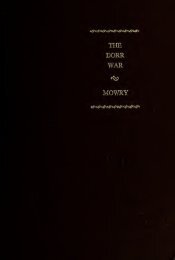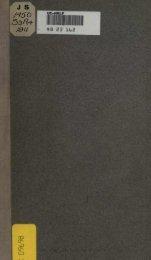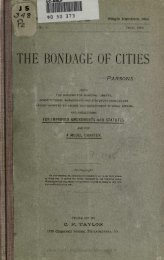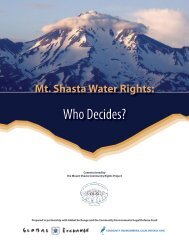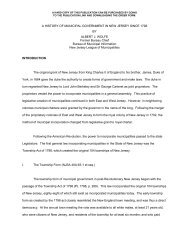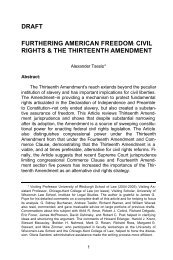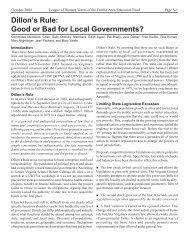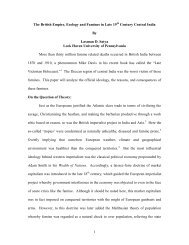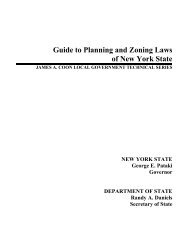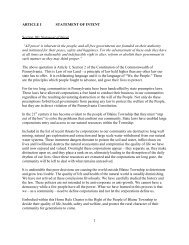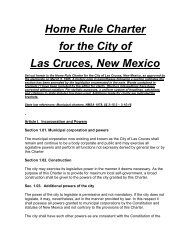Connecticut - The Community Environmental Legal Defense Fund
Connecticut - The Community Environmental Legal Defense Fund
Connecticut - The Community Environmental Legal Defense Fund
- No tags were found...
Create successful ePaper yourself
Turn your PDF publications into a flip-book with our unique Google optimized e-Paper software.
FEATURES B Wild LawAt the recent CEJ conference, Hoskenspoke on “Earth Jurisprudence: Lessonsfrom Indigenous Peoples.” To explain thelink between wild law and indigenouswisdom, she says, “Indigenous peoplesee themselves as part of a living whole.That’s their cosmology, that’s their worldview based on Earth lore. And of course,that’s what Earth jurisprudence is tryingto say, that the Earth is the primary giverof law, the primary text, and that humanbeings should regulatethemselvesaccording to that primarylaw, and thatlaw as it governs alllife systems.”…the fact that CEJ isfounded within two<strong>The</strong> methodologythat the GaiaFoundation, theAmazonians, andthe Africans havedeveloped is basedon tapping into thewisdom of the eldersor “knowledgeholders” in anycommunity, thosewho know the workingsof the primary law in their particularecosystem, with the goal of reconnectingthe whole community to that naturalworld. <strong>The</strong> first step is to identify theknowledge holders and hold communitymeetings to stimulate community dialogueand create a map of the community’secosystem. Hosken describes thiseco-mapping as “a very interesting powerfultool for bringing out the knowledgeof the wisdom holders and engagingothers in connecting with their place andunderstanding how it works.” In theprocess, community members connectwith each other in a new way, and cohesionis re-established as a basis for goodgovernance. <strong>The</strong> young gain new respectfor their elders and the traditions of theirpeople, their heritage, and their identity.Excitingly, Hosken and her colleagueshave discovered that the methodologyworks as well in communities in developedcountries as it does in the Amazonand Africa.Restoring wild law at a grass-roots level,in individual communities, and linkingthose communities in a region, throughouta country, and internationally is howwild law will become the law of theland. Hosken notes that the Amazonianstalk about sacred sites as critical placeswhere the Earth needs to rest and beprotected andthat these sitesused to all belinked. “Of allthe things weneed to do—thedestruction is sohuge, but wehave to beginsomewhere—they say to usthat sacred sitesare the placeswe really needto prioritize inany ecosystem,”she says. “<strong>The</strong>vision they haveis that we workwith these little small nodes of interestedpeople in different countries and tryto get this process going, and try andget it to spread and to link up into aglobal alliance. <strong>The</strong> interlinkage is a reallyimportant part of building up the criticalmass for change.” And it is theknowledge keepers in your communitywho know where the sacred sites are inyour ecosystem.faith-based law schools isno accident, but reflectstheir common groundwith the wild lawmovement of “recognitionof the sacredness ofthe natural world, thesacredness of creation.”A Landmark Law PassesRecent events in Pennsylvania highlightAmerican communities that are takingback control of their own ecosystemsand restoring nature’s stolen rights. OnSeptember 19, 2006, the TamaquaBorough Council in Pennsylvaniabecame the first municipality in the U.S.to strip corporations of rights and recognizethe rights of nature, thus becomingthe first in the country to enact wild law.<strong>The</strong> council passed an ordinance prohibitingcorporations from applyingsewage sludge in the borough. (Landappliedsewage sludge is a known hazardto the health of humans and theenvironment.) Four other communities inthe state have since passed similar ordinancesdenying corporations personhoodand recognizing nature instead.<strong>The</strong> municipalities were able to do thiswith the assistance of the <strong>Community</strong><strong>Environmental</strong> <strong>Legal</strong> <strong>Defense</strong> <strong>Fund</strong>(CELDF), a nonprofit law firm inChambersburg, Pennsylvania, that provideslegal services to groups and localgovernments seeking to protect theircommunity’s quality of life and naturalenvironment. CELDF’s cofounder andexecutive director, attorney ThomasLinzey, now receives calls from all overthe country from communities facingunwanted incursions by corporations.<strong>The</strong> first thing he helps them figure outis how to regain control of their local governmentif they don’t already have it, or ifthey do, what ordinances they need topass to keep the toxic waste incinerator,sewage sludge, factory farm, cell phonetower, or other environmental hazard outof their community.CELDF’s project director, Ben Price, saidof the landmark Tamaqua ordinance, thatthe council took “an extraordinary—butlogical—step. Since this nation’s founding—andfor thousands of yearsbefore—‘law’ in the Western world hastreated rivers, mountains, forests, andother natural systems as ‘property’ withno rights that governments or corporationsmust respect. This has resulted inthe destruction of ecosystems and naturalcommunities, backed by law, publicpolicy, and the power of government.<strong>The</strong> people of Tamaqua have changedhow the law regards Nature, and haveacted in the grand tradition of theAbolitionists, who launched a people’smovement in the 1830s to end the legalbut immoral treatment of slaves as prop-erty and to establish forever their rightsas people entitled to fundamental andinalienable human rights.” With these“new-generation ordinances,” as Linzeycalls them, Nature’s inalienable rights arebeginning to be restored, and the fivePennsylvania communities are likely thestart of a movement.<strong>The</strong> wild law heroes described here andthe many others working in a variety ofways toward the goal of restoring therights of Nature cannot alone bringabout the paradigm shift from our currentanthropocentrism to a worldview ofourselves as members of an Earth communitythat includes all beings and naturalelements. But the more of us whotake action toward this goal, the closerwe will be to wild law, perhaps suddenly,becoming the status quo instead ofbeing regarded as a radical or idealisticconcept. ■For Cormac Cullinan, visitwww.enact-international.com;for Liz Hosken and the Gaia Foundation,visit www.gaiafoundation.org;for Thomas Linzey and CELDF, visitwww.celdf.org or call 717-709-0457;for Patricia Siemen and CEJ,visit www.earthjuris.orgor call 305-623-2389.FEATURES10THE NATURAL PAGES ® 0 MARCH-AUGUST 20085 TELL THEM YOU FOUND THEM IN THE CONNECTICUT NATURAL PAGES!11




